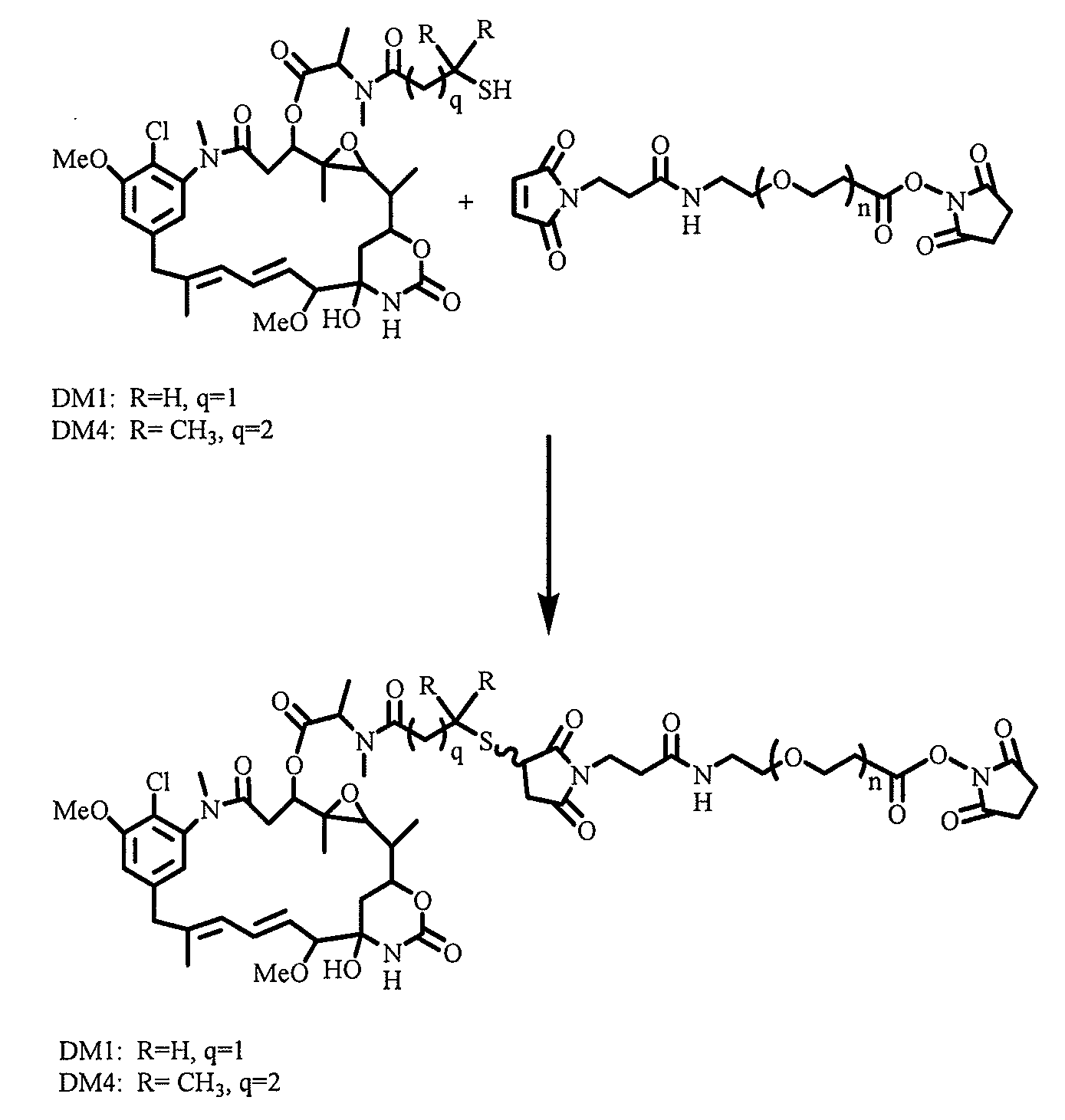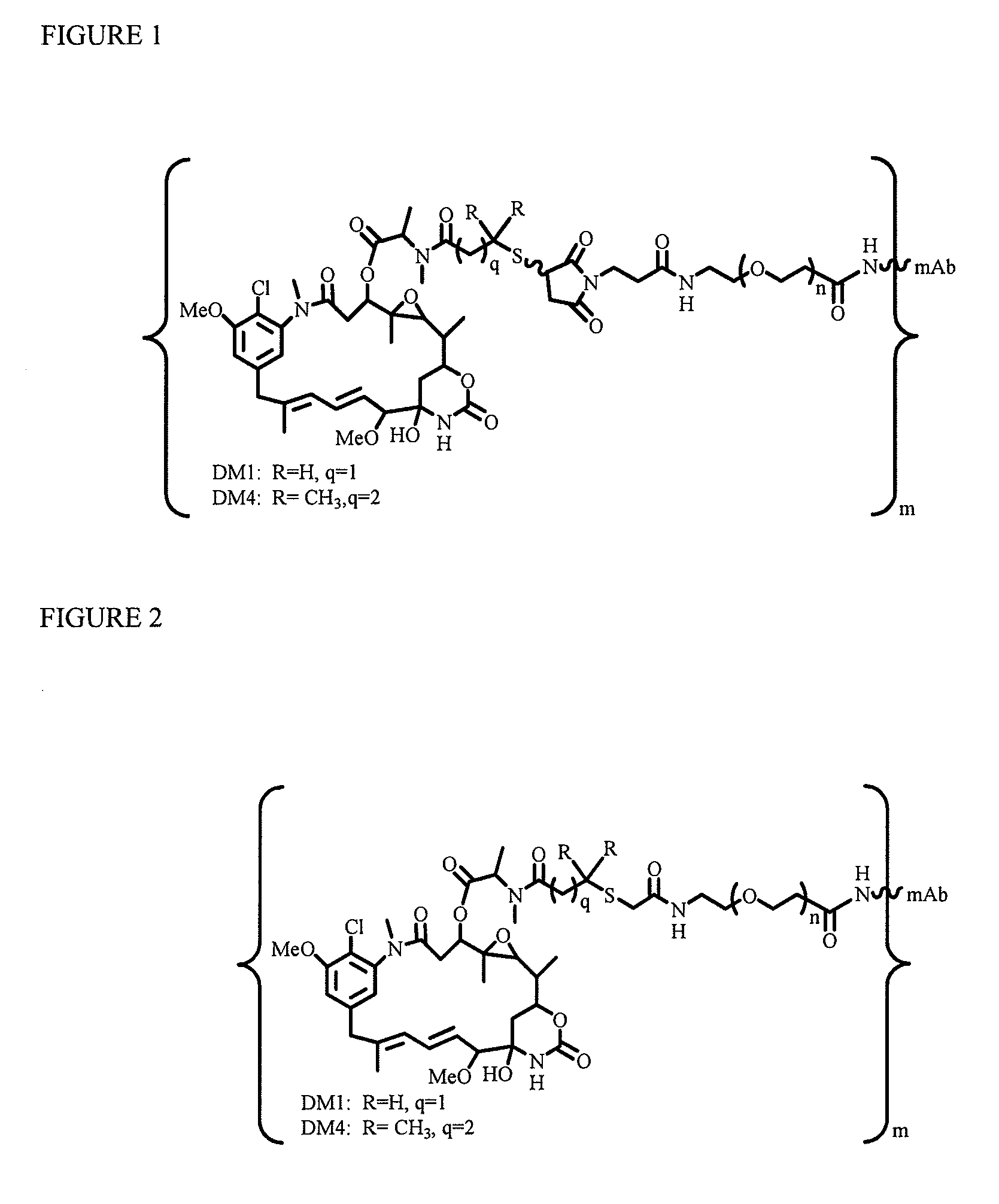Potent conjugates and hydrophilic linkers
- Summary
- Abstract
- Description
- Claims
- Application Information
AI Technical Summary
Benefits of technology
Problems solved by technology
Method used
Image
Examples
examples
[0210]Without being bound by any particular aspect, methods are described for the synthesis of polyethylene glycol ((CH2CH2O)n)-linked drugs with different reactive linkers for conjugation with cell-binding agents. These conjugation methods include a one-step conjugation of antibody with drugs such as maytansinoids linked via polyethylene glycol ((CH2CH2O)n) linker by reaction at N-hydroxysuccinimide (NHS) reactive group.
[0211]Also, described are methods of synthesizing disulfide-group containing polyethylene glycol ((CH2CH2O)n)-linked drugs with different reactive linkers for conjugation with antibody. These conjugation methods include a one-step conjugation of antibody with drugs such as maytansinoid linked with disulfide-group having polyethylene glycol ((CH2CH2O)n) linker via reaction at a N-hydroxysuccinimide (NHS) reactive group.
[0212]The following examples, which are illustrative only, are not intended to limit the present invention.
example i
Conjugation of Antibody with Several Maytansinoid Molecules Linked Per Antibody Molecule by Disulfide Linkers Containing Traditional Aliphatic Carbon Spacers
[0213]In a two-step process to conjugate an antibody with several molecules of the maytansinoid DM4 or DM1, a humanized antibody was first modified with a commercially available heterobifunctional linker (SPDB) containing both an amine-reactive N-hydroxysuccinimide group (NHS group) and a thiol-reactive 2-pyridyldithio group (—SSPy group) to incorporate several molecules of the linker in the antibody molecule (as described in W. C. Widdison et al., J. Med. Chem., 2006, 49, 4392-4408). Following the incorporation of the reactive linkers in the antibody molecule, in a second reaction step the maytansinoid DM4 or DM1 with a reactive thiol group was added to the linker-modified antibody to conjugate the maytansinoid to antibody by disulfide bonds. In a specific example, a humanized antibody at a concentration of 5-10 mg / ml was modif...
example ii
Conjugation of Antibody with Several Maytansinoid Molecules Linked Per Antibody Molecule by Disulfide Linkers Containing Hydrophilic Polyethylene Oxide Spacers (PEGn, or (—CH2—CH2—O)n=1-14)
[0214]To explore if hydrophilic spacers such as polyethylene oxide (PEGn, or (—CH2—CH2—O)n=1-14) could perhaps prevent the aggregation and precipitation of antibody-maytansinoid conjugates with a high number of maytansinoid molecules (>4 average per antibody molecule), several new heterobifunctional and monofunctional maytansinoid derivatives were prepared which could be conjugated to antibody by direct modification or a two-step reaction involving the initial derivatization of antibody at lysine residues followed by the reaction of maytansinoids (see, for examples, FIGS. 3, 6, 11, and 12).
Synthesis of 15-(2-pyridyldithio)-4,7,10,13-tetraoxapentadecanoic acid
[0215]A solution of aldrithiol-2 (1.17 g, 5.31 mmol) was prepared in 5.0 mL of 1,2-dimethoxyethane in a 10 mL round bottom flask. To the reac...
PUM
| Property | Measurement | Unit |
|---|---|---|
| Time | aaaaa | aaaaa |
| Fraction | aaaaa | aaaaa |
| Cytotoxicity | aaaaa | aaaaa |
Abstract
Description
Claims
Application Information
 Login to View More
Login to View More - R&D
- Intellectual Property
- Life Sciences
- Materials
- Tech Scout
- Unparalleled Data Quality
- Higher Quality Content
- 60% Fewer Hallucinations
Browse by: Latest US Patents, China's latest patents, Technical Efficacy Thesaurus, Application Domain, Technology Topic, Popular Technical Reports.
© 2025 PatSnap. All rights reserved.Legal|Privacy policy|Modern Slavery Act Transparency Statement|Sitemap|About US| Contact US: help@patsnap.com



